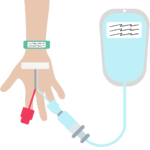This guide provides information about what to do before your female sterilization surgery and what to expect from your healthcare providers. It’s very general, so there might be slight differences in approaches depending on the country you’re in. There might be slight differences in what happens depending on the surgery type you’re undergoing. We at SterilizationAunty wrote this with undergoing a bilateral tubal ligation in mind. This article assumes you’ve never had surgery before, and that you’re not familiar with the steps.
Before arriving at the hospital
After you’ve spoken to your doctor about bilateral tubal ligation surgery and received your doctor’s approval, decided on a surgery date and time, you will go in pre-surgery or pre-op. Your surgeon will give you instructions on what to do before surgery. This usually includes the following advice:
- Bring your identification document or passport with you
- Arrange care for any dependents you might have for the time you’ll be at the hospital
- Arrange transportation back home after surgery
- If another adult will accompany you during your hospital stay, make sure the hospital knows
- Follow your doctor’s guidelines regarding what medication you can or cannot use
- Avoid shaving or otherwise tampering with the area where your incisions will be
- No eating, drinking or smoking 12 hours before your surgery time (also known as fasting)
- Also, avoid binge-eating before your fast starts
- Remove all makeup, nail polish, and piercings and jewelry from your body
- Bring comfortable clothing that is not tight at the belly
- Bring footwear that doesn’t require you to bend over
- Bring entertainment, such as a book or a game
Failing to follow your doctor’s advice may result in your bilateral tubal ligation surgery being canceled.
Your surgery may be in the morning, the afternoon, or even late at night. Fasting is tougher when your surgery is in the evening than when you have your operation in the morning after sleeping for many hours.
Note: there are some surgeons who don’t want to operate on you during your menstruation. Your womb and other organs can be a bit swollen during that time and it can be a bit messy for the person who catheterizes you. If you have a predictable cycle, you can plan your female sterilization surgery when you’re not menstruating. If you have an irregular cycle, you need to tell your surgeon that you can’t guarantee you won’t be menstruating. They’re doctors and they should understand this even if your body doesn’t work like the textbooks.
Presurgery at the hospital
Sometimes, you stay at the hospital many hours before surgery. Other times, you go into surgery almost immediately. Once you arrive at the hospital, you have to do a few things before the surgeon can operate on you.
First, an administrator will admit you to the hospital as a patient. For this, you’ll need to show your identification and sign some forms. After the administration completed your registration, you’ll receive a patient bracelet that has your details on it.
From there, a nurse will take you with to get changed into a hospital gown. They will weigh you, take your blood pressure, and measure your body temperature. After this, they might put intravenous (IV) fluids in your body via a needle in your hand. This is to keep you hydrated without excess and keep your electrolytes up((Source: https://anesthesiology.pubs.asahq.org/article.aspx?articleid=2725468)). It can be quite uncomfortable, but should not be painful. There are at least two tube ports on this; one is for receiving drips of IV fluids, while the other is for injecting the anesthetic right before surgery.
The anesthesiologist needs to know your weight to decide how much anesthesia to give to you. Having abnormal blood pressure may make surgery more dangerous. Having a high temperature (hyperthermia or fever) might indicate that you have an infection, which can be dangerous for hospital staff or other patients. A mild fever may not be a reason to postpone surgery. Slight hypothermia (being cold) before surgery isn’t generally considered a risk factor before surgery. Normal body temperature is between 36.5°C – 37.5°C in Celsius, or 97.7°F – 99.5°F if you use Fahrenheit. The nurses might repeat the measuring of your blood pressure and your temperature many times before your surgery time.
In many cases, you’ll also fill in a questionnaire before surgery, do an electrocardiogram (ECG or EKG, depending on where you’re from) to look at your heart rate. Perhaps they’ll also do an x-ray of your belly. This will depend on your hospital’s policies. If you’re a non-wheelchair user, you sometimes won’t walk anymore without the help of a nurse after getting changed into a gown. While at other times you’re still allowed to walk around independently.
Either via blood or urine, the nurses will also do the last pregnancy test you’ll ever need to take. If you test positive for pregnancy, your surgery will be canceled or postponed.
Meeting your surgeon and their surgical team
While in your room, your surgeon will visit you before the operation with a nurse to read your statistics and talk to you. If you’ve never met your surgeon before, you’ll be acquainted now. This also functions as one of the final checks to see if you want to go through with this. In some countries, a person from the hospital’s accounting department might visit you to inform you about the costs you’re building up.
When your surgery time approaches, the nurses might help you go to the bathroom one more time. They’ll then help you get dressed in your surgical gown. They will then move you into your operative bed, which is a narrow bed to transport you to the operating theater.
Once you’re in the area around the operating theatre, administrative nurses will once more check your identity and your surgery type. They will check whether you’re still wearing any jewelry, makeup, or piercings. These items aren’t sterile and must be removed before entering the sterile operating theatre. Your nails need to be free from nail polish to check your vitals during surgery. A nurse will help put on a shower cap to keep your hair away. They might do some more tests here or ask you some questions about allergies to medications. You’ll meet your anesthesiologist here too.
Things might be a little hectic or stressful for you here. There are a lot of people working to make sure your female sterilization surgery goes well. One of the nurses might still ask you about your decision to never have children. Don’t feel stressed out by this question; they’re often just curious and not automatically judgmental. You’re already here in your gown and they will absolutely perform your surgery unless you say you don’t want to become sterile.
In the operating theatre before and right after anesthesia
 You’ll then be brought into the operating theatre where your surgeon will be. Maybe your surgeon is hard to recognize because of their surgical clothes and covered face and hair. You’ll have to move from your surgical bed to the sheet on the operation table with the help of the surgical team. They can also lift you there if it’s too difficult. Make sure to not move too fast since the team will need to make sure your IV fluids won’t be tangled.
You’ll then be brought into the operating theatre where your surgeon will be. Maybe your surgeon is hard to recognize because of their surgical clothes and covered face and hair. You’ll have to move from your surgical bed to the sheet on the operation table with the help of the surgical team. They can also lift you there if it’s too difficult. Make sure to not move too fast since the team will need to make sure your IV fluids won’t be tangled.
Once on the table, things will move very fast. You’ll receive a heartbeat monitor on your finger. Someone might prepare a cloth with a hole for your belly to operate through or sterilize the incision site with iodine already. Your anesthesiologist will use the free tube port on your IV fluid system on your hand to give you the anesthetic. Someone will give you oxygen and you’ll probably be unconscious very quickly. Some people experience this similarly to falling asleep, but in a very strange way.
Right after you’re out, a nurse might put a catheter through your urethra to make sure you won’t accidentally pee during or after surgery. You’ll keep this catheter until well after surgery. The surgical team will intubate you to help you breathe. Once your incision site is prepared, your surgeon will start your chosen female sterilization procedure by making an incision.
After surgery: waking up in the operating theatre
As the effects of anesthesia wear off after your surgery, you might notice the intubation in your throat and start coughing. This can be a little scary, but someone will extubate you soon after. The first thing you might notice is a dry or sore throat. Then, you might notice some pain at your mouth from the tube and the tape held it in place. If you’re trying to talk, you might notice that this is difficult or that your voice sounds strange. And finally, you might notice that you’re quite cold, uncomfortable, and a little disoriented.
But you’ve done it. You’re sterile now!
Once the surgeon deems you ready, the surgical team will move you from the operation table back to the operative bed you arrived in. They will do this by lifting the sheet you’ve been lying on. It’s a three-person job. Next, you might notice that you’re catheterized. The tube from your urethra to the collection bag is taped to your leg so it won’t accidentally pull out during moving.
The team will move you away from the operating table back to the room you were in right before your surgery. You’ll spend some time here while nurses check your vitals and if you’re okay. If you’re cold, they will put blankets on you to make you more comfortable. This is when you might notice your operation site for the first time. Your belly might be sensitive and a little painful, but not unmanageable. The anesthesia wearing off and various sensations can make you feel quite uncomfortable during this time, but this will pass. Try to sleep a little when nurses aren’t talking to you.
Once you’re cleared to leave the surgical area, you’ll be transported back to your room. There you’ll see any person who stayed with you at the hospital. Nurses will help you move into your comfortable bed where you will spend some time resting and recovering.
Resting and recovering in your room
Depending on the type of surgery, the time of day of your surgery, and the hospital, you’ll be discharged the same day or stay a few nights. Your hospital stay after the surgery looks very different depending on these factors.
Now you’re back in your room, your anesthetic might be wearing off and the numbness might leave your body. You might feel pain at the surgical site and be curious to look at it. If you have the energy, your nurse can help you look. This can be a little shocking. Your belly will be swollen from either the gas used during laparoscopy or from movement during a laparotomy. You can see the discoloration from the iodine used to sterilize the area. There will be bandages wherever the surgeon made incisions. Perhaps you’ll also spot your catheter tube.
You can drink and eat again. It’s a good sign if you can drink some water. A nurse will help you with that. It’s a good idea to try to sleep even if it’s not nighttime. Your nurses can bring you blankets if you’re cold and they’ll do their best to make you comfortable. Try to reduce movement as much as you can.
Once you wake up again, a nurse might want to see you sit up and eat something. Moving into a sitting position will make you use your abdominal muscles, during which you can feel pain. Nurses will also do more checks on you, such as a blood pressure measurement or empty your catheter bag. If you can’t sleep more, you might be bored, want your catheter removed, and be discharged. You might overestimate your strengths now, which can be dangerous. Try to entertain yourself with something instead. It’s nice to chat with the person you brought with if you did that and talk over your experiences.
If you had laparoscopic surgery, you might feel the distinct shoulder pain after sitting up. This is from the gas they used during surgery to inflate your belly. You can relieve this pain by lying horizontally again. This pain will only disappear after a few days after your surgery.
When the nurses think you’re ready to visit to the bathroom yourself, they will remove your catheter. This is a very uncomfortable sensation and makes you feel like you have no control whatsoever. There is no need to feel ashamed of that.
Getting discharged and going home
Your surgeon will visit you after your operation and tell you how it went. They will mention any complications that happened during surgery if there were any. You can ask your surgeon questions about your incisions. They will tell you how to take care of your bandages, what you can and can’t do, and make an appointment for about one week after the surgery to look at the healing process. The advice will depend on a lot of different factors. You might have to sign discharge papers if it’s time for you to go home.
Someone from the accounting department will visit you to show you the final bill. Depending on the country and your insurance, they’ll either give an unspecified total amount or directly an itemized bill. Make sure to get the itemized bill and read it in full. Here, you can find all the costs of your hospital stay: from the price of IV bags to bandages, room and meal cost, and the price of renting out the operating theatre. If there weren’t any complications, it’s likely that the cost will be the same as quoted before agreeing to the surgery. If your insurance covers the entire procedure, there’s a chance you won’t even see a bill.
The nurses will unhook you from the IV fluids and put a bandage where the hole is. You might need some help dressing back up. Put on your most comfortable clothes that aren’t tight at the belly. Putting on comfortable footwear that doesn’t require you to bend over is also a great idea.
Depending on the country and culture, someone will put you in a wheelchair and bring you to the pharmacy where you’ll receive your prescribed medicines. In other countries, you can walk there yourself or use your own wheelchair. This usually includes antibiotics, pain killers, and antacids. Depending on your country and insurance, you might have to pay for your surgery on the spot. You’re now ready to return home with your predetermined transportation.

